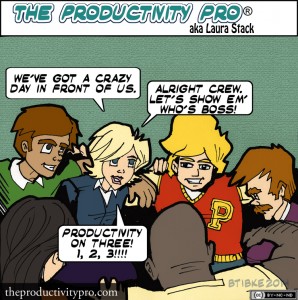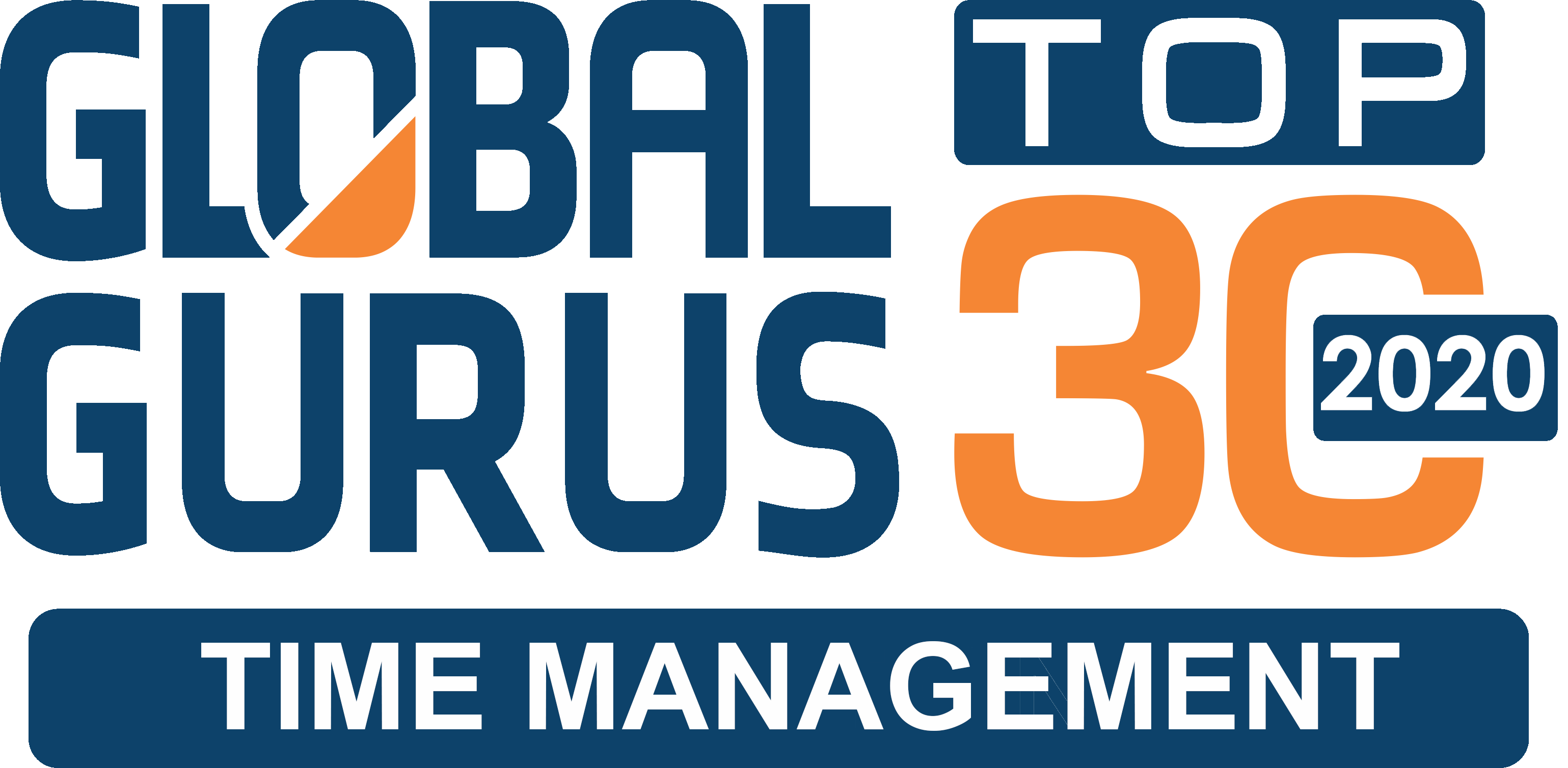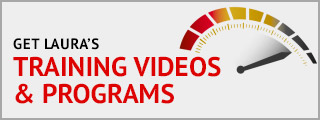“One of my favourite tricks is to conduct most of my meetings standing up. I find it to be a much quicker way of getting down to business, making a decision and sealing the deal.” ― Sir Richard Branson, British businessman
Here is the bi-weekly roundup of activity from Laura Stack’s blog, columns, podcast, and other featured articles. Scroll down to read the complete roundup of productivity resources to help you create Maximum Results in Minimum Time.
This week on the Blog
Stand-Up Guys: The Virtues of Standing Meetings
 In the white-collar world, sitting down all day is both a blessing and a curse. Sitting makes it a lot easier to focus our intellects, since we’re basically in a resting but erect position; this also allows us to work interrupted for longer periods of time. But there can be side effects; too little physical exercise (as opposed to the mental exercise we enjoy daily) worsens the natural tendency toward “middle-aged spread” and makes us more sedentary. This results in less energy, slowing our productivity. Sitting too much can also interfere with or damage the circulatory process in our legs.
In the white-collar world, sitting down all day is both a blessing and a curse. Sitting makes it a lot easier to focus our intellects, since we’re basically in a resting but erect position; this also allows us to work interrupted for longer periods of time. But there can be side effects; too little physical exercise (as opposed to the mental exercise we enjoy daily) worsens the natural tendency toward “middle-aged spread” and makes us more sedentary. This results in less energy, slowing our productivity. Sitting too much can also interfere with or damage the circulatory process in our legs.
This is doubtless the reason why stand-up desks have become common (I love mine from Ikea). But who wants to stand all day? At some point, you tire of standing, your feet and ankles hurt, and you still have to stretch your legs frequently. Ultimately, a mixture of standing and sitting throughout the course of the day may prove most advantageous, though the jury remains out on this issue.
Be that as it may, some things you can do standing definitely boost your productivity. One is the stand-up meeting. Attendees ignore chairs, huddle together almost like football players, and talk as they would in a normal sitting meeting. Studies show standing meetings average 33% shorter than sitting meetings on the same subjects, proceed more efficiently, and usually end early or on time. And here’s the kicker: they burn 50% more calories, and actually have other positive health effects, including increased alertness. No wonder speakers and performers are always much more likely to stand than sit, above and beyond the need to be seen by everyone!
It’s no surprise that stand-up meetings run shorter than sit-down ones. After all, who really wants to stand in one place for an hour in even the most comfortable heels or loafers? There’s a good reason the gluteus maximus is the largest muscle in the human body, right? If nothing else, physical discomfort forces us to confront and deal with our concerns more directly in a stand-up meeting.
Other Stand Up Benefits
Besides saving time, stand-up meetings usually cover brief, simple subjects that rarely take longer than half an hour to discuss anyway. Sir Richard Branson actually prefers walking during meetings to simply standing, so the paths of his usual haunts are well trod by him and his associates; this burns even more calories, and can up your energy in the process as it fights off sluggishness and helps you lose weight. Even motionless stand-ups offset the increased rate of cardiovascular disease, diabetes, and other ailments that sitting too much can encourage.
Those who’ve experienced both types of meetings have noted some disadvantages of stand-up meetings. If you don’t provide everyone with stand-up desks, they have to bend over to take notes on their laptops, stressing their back muscles. And then there’s the tiring and cramping of leg muscles when one stands too long, an avoidable issue when the meetings remain short. Some larger or less healthy people may feel the strain almost immediately, so it may be best to let them sit as needed, so they can concentrate on the meeting rather than their own discomfort.
Stand-Up Protocols
Alert your meeting attendees in advance that they will be attending a stand-up meeting, and remind them again when they arrive. Remind them of a stand-up meeting’s benefits, and tell them they can sit when they need to. Before beginning, push the chairs to the sides of the room and set up visual tools like a whiteboard or easel to make it easier to transmit ideas. Short PowerPoint presentations may work fine for some.
Interestingly, a Washington University study reveals that people act less territorial and more collaborative in stand-up meetings; this may be one reason stand-ups are shorter than traditional meetings. The researchers suggest this may occur because standers are less likely to stake out their personal space than sitters, making them less individual-oriented and more team-oriented.
If you adopt stand-up meetings, you’ll doubtless have to experiment with the format before it settles in. Do what works naturally for your team, whether that means sharing a cup of tea first or using a special board to determine who should speak at any given time. Keep in mind that attendees can bring little more than what they can hold in their hands, so taking audio notes with a smartphone or mini-recorder may work better than taking notes by hand. Otherwise, the format should remain whatever you and your team have become familiar with, as long as that format remains logical when standing.
When meetings take less time, you’ve got an opportunity to seize higher productivity. (<– Click to Tweet.) Give stand-ups a chance, and if you need to modify them to half stand-up, half sit-down or in some other way, don’t hesitate to do so. Just find the happy medium that suits you all and saves time.
If you have stand-up meetings, what practices do you find work well?
On LinkedIn:
Team vs. Work Group: How Do You and Your Coworkers Stack Up?
 Most of us who work with multiple coworkers consider ourselves part of a team, and in fact, our leaders may refer to us as such. But are you really part of a team? Strictly defined, a team consists of a cohesive group of individuals, all of whom work within the same workflow process, contributing to the completion of one or more cooperative projects.Read More on LinkedIn.
Most of us who work with multiple coworkers consider ourselves part of a team, and in fact, our leaders may refer to us as such. But are you really part of a team? Strictly defined, a team consists of a cohesive group of individuals, all of whom work within the same workflow process, contributing to the completion of one or more cooperative projects.Read More on LinkedIn.
In the news:
The Top 20 Productivity Influencers on Twitter at Tribe
Laura Stack’s New Book Will Help Companies to ‘Do the Right Things Right’ at PR Underground
Recommended Articles:
Returning to ready, aim, fire: The power of the pause
5 Secrets to Managing Your Time, Backed by Research
Podcast
Tune in this week as Laura talks about Facilitating an Effective Teleconference.
© 2015 Laura Stack. Laura Stack, MBA, CSP, CPAE is an award-winning keynote speaker, bestselling author, and noted authority on employee and team productivity. She is the president of The Productivity Pro, Inc., a company dedicated to helping leaders increase workplace performance in high-stress environments. Stack has authored seven books, including her newest work, Doing the Right Things Right: How the Effective Executive Spends Time (Jan. 2016). She is a past president of the National Speakers Association, and in 2015 was inducted into its exclusive Speaker Hall of Fame (with fewer than 175 members worldwide). Stack’s clients include Cisco Systems, Wal-Mart, and Bank of America, and she has been featured on the CBS Early Show and CNN, and in the New York Times. To have Laura Stack speak at your next event, call 303-471-7401 or visit her website.



[…] Guys: The Virtues of Standing Meetings https://theproductivitypro.com/blog/2015/12/stand-up-guys-the-virtues-of-standing-meetings/ by Laura Stack (@laurastack) Key Takeaway: Studies show that stand-up meetings are generally […]